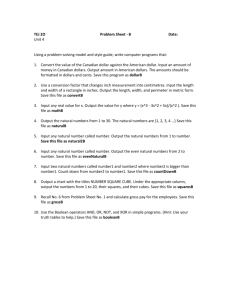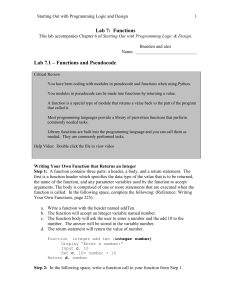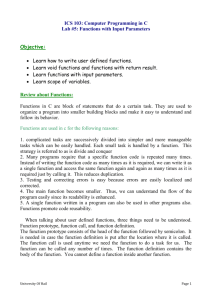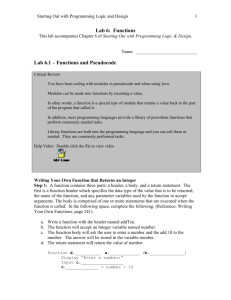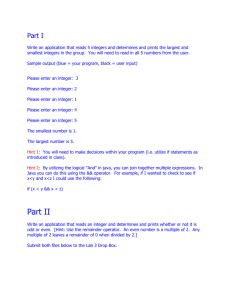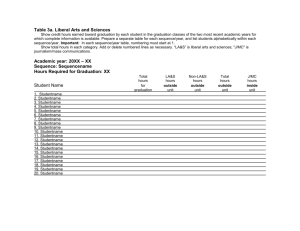File - Devin`s Baker College ePortfolio
advertisement
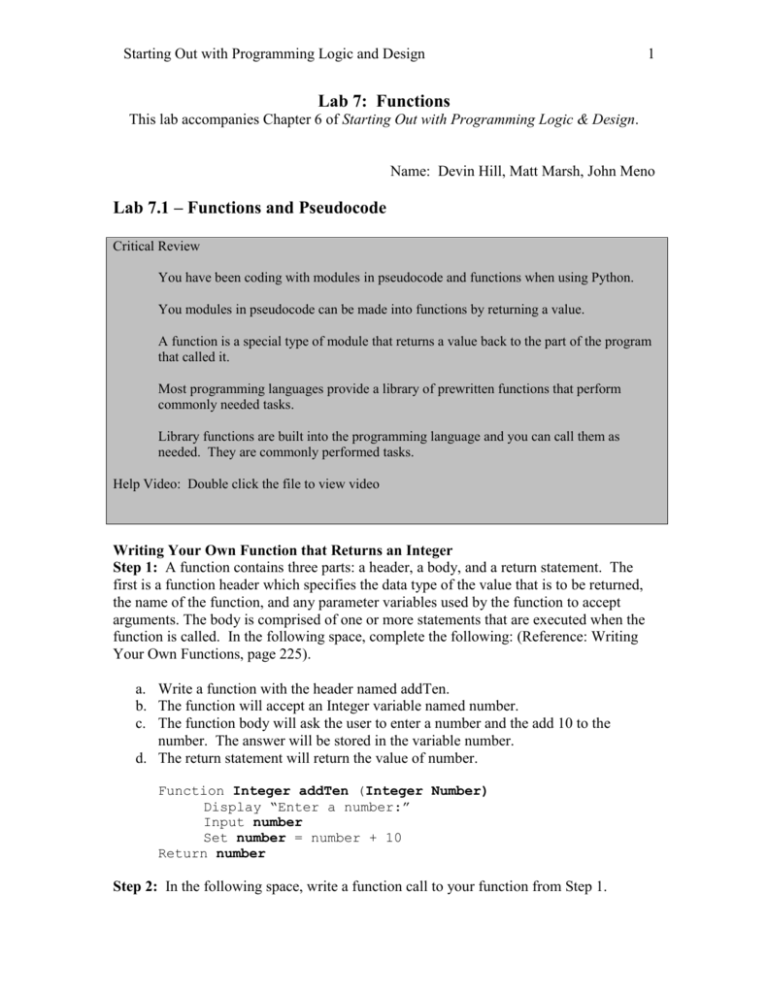
Starting Out with Programming Logic and Design
1
Lab 7: Functions
This lab accompanies Chapter 6 of Starting Out with Programming Logic & Design.
Name: Devin Hill, Matt Marsh, John Meno
Lab 7.1 – Functions and Pseudocode
Critical Review
You have been coding with modules in pseudocode and functions when using Python.
You modules in pseudocode can be made into functions by returning a value.
A function is a special type of module that returns a value back to the part of the program
that called it.
Most programming languages provide a library of prewritten functions that perform
commonly needed tasks.
Library functions are built into the programming language and you can call them as
needed. They are commonly performed tasks.
Help Video: Double click the file to view video
Writing Your Own Function that Returns an Integer
Step 1: A function contains three parts: a header, a body, and a return statement. The
first is a function header which specifies the data type of the value that is to be returned,
the name of the function, and any parameter variables used by the function to accept
arguments. The body is comprised of one or more statements that are executed when the
function is called. In the following space, complete the following: (Reference: Writing
Your Own Functions, page 225).
a. Write a function with the header named addTen.
b. The function will accept an Integer variable named number.
c. The function body will ask the user to enter a number and the add 10 to the
number. The answer will be stored in the variable number.
d. The return statement will return the value of number.
Function Integer addTen (Integer Number)
Display “Enter a number:”
Input number
Set number = number + 10
Return number
Step 2: In the following space, write a function call to your function from Step 1.
Starting Out with Programming Logic and Design
2
Set number = addTen (number)
Writing Your Own Function that Returns a Boolean Value
Step 1: A Boolean function will either return a true or a false value. You can use these
functions to test a condition. They are useful for simplifying complex conditions that are
tested in decision and repetition structures. In the following space, complete the
following: (Reference: Returning Boolean Values, page 238).
a. Write a function with the header named gender.
b. The function will accept a Boolean variable named answer.
c. The function body will ask the user to enter their gender into the variable type and
then determine if they are male or female with an if statement.
d. The return statement will return the value of answer.
Function a. Boolean a. gender (b. Boolean Answer)
Declare String type
Display “Enter your gender (male or female):”
Input c.type
If (c.type == “male”) then
answer = False
Else
answer = True
End If
Return d.answer
Step 2: In the following space, write a function call to your function from Step 1.
Set answer = gender (answer)
Using Mathematical Library Function: sqrt
Step 1: The sqrt function accepts an argument and returns the square root of the
argument. In the following space, complete the following: (Reference: The sqrt
Function, page 240).
a. Declare a variable named myNumber and a variable named squareRoot of the
data type Real.
b. Ask the user to enter a number of which they want to find the square root. Store
the input in myNumber.
c. Call the sqrt function to determine the square root of myNumber.
d. Display the square root to the screen.
Declare Integer a.myNumber
Declare Real a.sqaureRoot
Display “Enter a number:”
Input b. myNumber
Set c.squareRoot = sqrt (myNumber)
Starting Out with Programming Logic and Design
3
Display “The square root is”, d.squareRoot
Using Formatting Functions
Step 1: Most languages provide one or more functions that format numbers in some
way. A common use of formatting functions is to format numbers as currency amounts.
While a specific programming language will have its own name for formatting currency,
use the function currencyFormat for pseudocode. In the following space, complete the
following: (Reference: Formatting Functions, page 246).
a. Declare a variable named subtotal, a constant variable named tax set to the rate of
.06, and a variable named total.
b. Ask the user to enter the subtotal. Store the input in subtotal.
c. Calculate the total as subtotal + subtotal * tax.
d. Make a call to the currencyFormat function and pass it total. Since you are not
displaying it on this line, simply set the return value to total.
e. Display the total to the screen.
Declare Real a. subtotal
Declare Constant Real a. tax = .06
Declare Real a. total
Display “Enter the subtotal:”
Input b. subtotal
Set c. total = subtotal + subtotal * tax
total = d. currencyFormat (total)
Display “The total is $”, e. total
Starting Out with Programming Logic and Design
4
Lab 7.2 – Functions and Flowcharts
Critical Review
When creating a flowchart for a program that has functions, draw a separate flowchart for
each function.
The starting terminal symbol usually shows the name of the function, along with any
parameters that the function has.
The ending terminal symbol reads Return, followed by the value or expression being
returned.
In Raptor, there are built-in procedures and functions that perform a wide variety of tasks
on the programmer's behalf, saving development time and reducing the chance for errors.
Raptor's buily-in functions can return values, but modules made by the user do not have
that ability.
Raptor has the following built-in functions.
basic math:
rem, mod, sqrt, log, abs, ceiling, floor
trigonometry:
sin, cos, tan, cot, arcsin, arcos, arctan, arccot
miscellaneous:
random, Length_of
If you want to learn what each of these functions do, use the Help menu in Raptor and
search for the function name.
While ceiling and floor round a number to the nearest integer, there is no function
in Raptor that will round a number just to two decimal places.
The random function in Raptor takes no arguments. To generate a random integer from
1 to n, use floor((random*n) + 1). For example, you can simulate the roll of a
die (random number from 1 to 6) with floor((random * 6) + 1).
Help Video: Double click the file to view video
This lab requires you to create the flowchart from page 222 on Using Random Numbers
using the RANDOM function. Use an application such as Raptor or Visio.
Step 1: Start by reading the pseudocode on page 221 and 222 of your textbook on Using
Random Numbers. In addition to simply displaying the random values, your program
will also meet the following requirements:
Allow the two players of the dice game to enter their names in variables named
playerOne and playerTwo.
Based on the random roll of the dice, your program will determine which value is
higher or if they tie and declare one player a winner.
Starting Out with Programming Logic and Design
5
Create structure in your program by creating the following modules:
o An inputNames( ) module that will ask the players to enter their names
o A rollDice( ) module that will call the RANDOM function and determine
the winner. This will be done with a decision statement.
o A displayInfo( ) module that will print the winners name to the screen.
Additionally, your program should allow the same players to play as many times
as they want.
Step 2: Start Raptor and save your document as Lab 7-2. The .rap file extension will be
added automatically.
Step 3: Start by adding a comment box with the necessary variables.
Step 4: Add your loop to run multiple times and your module calls in the main module.
Your flowchart might look as follows:
Step 5: Code the inputNames( ) module so both players can enter their name into the
appropriate variable.
Step 6: Go to the rollDice( ) module and add an assignment statement. Assign
p1number to whatever the RANDOM function return. The assignment box input box
should look as follows:
Step 7: Add a second assignment statement and do the same for p2number.
Step 8: Add a selection statement that will determine which number is larger, or if there
is a tie. The best way to do this is to create a nested if else where you first check to see if
p1number is equal to p2number. If so, assign winnerName equal to “TIE”. If not, create
a second decision to see if p1number is greater than p2number. If so, then winnerName
should be set equal to playerOne and if not then winnerName should be set equal to
playerTwo.
Step 9: Go to the displayInfo( ) module and print the winners name to the screen.
Step 10: Paste your finished flowchart in the space below.
Starting Out with Programming Logic and Design
6
Starting Out with Programming Logic and Design
7
Starting Out with Programming Logic and Design
8
Starting Out with Programming Logic and Design
Lab 7.3 – Python Code and Random
Critical Review
A value-returning function is a function that returns a value back to the part of the
program that called it. In Python, you have been using value-returning functions and
those that do not.
Recall the function calls from Lab 6-4. The first call returns number back to the
number variable. The second call just displays a value and there is no need to return a
value.
number = getNumber(number) #value returning function
printAverage(averageScores) #function returns no value
Standard Library Functions
Python comes with a standard library of functions that have already been written for
you. These functions, known as library functions, make a programmer’s job easier
because they perform many of the tasks that programmers commonly need to perform.
In fact, you have already used several of Python's library functions. Some of the
functions that you have used are input, raw_input, and range. Python has many
other library functions.
The random Function
In order to use the random function in Python, you must import the random library.
This loads the library into memory so that you can use the functions that exist within
it. To do this, simply add the following line to the top of your code:
import random
One of the functions in the random library is the random.random.int( ) module. This
module accepts two arguments with the first being the starting number and the second
being the ending number. The following is how you would get a random number
between 1 and 6.
p1number = random.randint(1, 6)
Writing your own Value-Returning Functions
We have already written our own value returning functions that return one variable to
the place where the function was called.
However, you can also return more than one value in Python. The function call
might look as follows:
playerOne, playerTwo = inputNames(playerOne, playerTwo)
The return statement looks as follows:
return playerOne, playerTwo
Help Video: Double click the file to view video
9
Starting Out with Programming Logic and Design
10
The goal of this lab is to convert the Dice Game in Lab 7.2 to Python code.
Step 1: Start the IDLE Environment for Python. Prior to entering code, save your file by
clicking on File and then Save. Select your location and save this file as Lab7-3.py. Be
sure to include the .py extension.
Step 2: Document the first few lines of your program to include your name, the date, and
a brief description of what the program does.
Step 3: Start your program with the following code for main:
#Lab 7-3 The Dice Game
#add libraries needed
#the main function
def main():
print
#initialize variables
#call to inputNames
#while loop to run program again
while endProgram == 'no':
#initialize variables
#call to rollDice
#call to displayInfo
endProgram = raw_input('Do you want to end program?
(Enter yes or no): ')
#this function gets the players names
#this function will get the random values
#this function displays the winner
# calls main
main()
Starting Out with Programming Logic and Design
11
Step 4: Under the documentation for adding libraries, add the following statement:
import random
Step 5: Under the documentation for initialize variables, set endProgram to ‘no’ and
playerOne and playerTwo to ‘NO NAME’.
Step 6: Under the documentation for making a call to inputNames, set the function call
to both playerOne and playerTwo and pass both variables to the function as arguments.
This must be done because both values need to be returned from the function. This is
done as follows:
playerOne, playerTwo = inputNames(playerOne, playerTwo)
Step 7: Inside your while loop, set winnersName to ‘NO NAME’ and p1number and
p2number to 0.
Step 8: Make a call to rollDice and pass the necessary variables needed in this function.
This function should be set to the winnerName as that variable will be returned from the
function. This is done as follows:
winnerName = rollDice(p1number, p2number, playerOne,
playerTwo, winnerName)
Step 9: Make a call to displayInfo and pass it winnerName.
Step 10: The next step is to write the function that will allow both players to enter their
names. Write a function heading that matches your function call in Step 6, making sure
to accept two arguments. The body of this function will use the raw_input function to
take in both players names, and one return statement that returns both playerOne and
playerTwo variable The return statement should look as follows:
return playerOne, playerTwo
Step 11: The next function to code is the rollDice function. Write the function header to
match the function call in Step 8. This function body will call the random function to
determine p1number and p2number. The code should look as follows:
p1number = random.randint(1, 6)
p2number = random.randint(1, 6)
Step 12: Next, inside this function write a nested if else statement that will set
winnerName to either playerOne name, playerTwo name, or “TIE”.
Step 13: The final step in this function is to return winnerName.
Starting Out with Programming Logic and Design
12
Step 14: The final function to code is the displayInfo function. Write the function
header to match the call made in Step 9. The body of the function should simply print the
winnerName variable to the screen.
Step 15: Execute your program so that all loops work and paste the final code below
import random
import string
def dice_get_player_names():
good=0
print('Hello world welcome to my amazing dice game!!!!!!')
Player_One_name=input('Player one please enter you name')
#Player_Two_name=input('Player Two please enter you name')
print(Player_One_name)
def Roll_The_Dice():
print('The dice of destany are ROLLED')
for x in range(random.randint(1,5)):
print('ROllING')
playerOneDice=random.randint(1,6)
playerTwoDice=random.randint(1,6)
if (playerOneDice == 6):
print('WOW'+Player_One_name+'You GOT a 6!!!!! GOOD
Luck'+Player_Two_name)
else:
print(Player_One_name+'You got a '+str(playerOneDice)+'Good luck!')
if playerOneDice==6:
print('WOW'+Player_Two_name+'You GOT a 6!!!!! GOOD
Luck'+Player_One_name)
else:
print(Player_Two_name+'You got a '+str(playerTwoDice)+'Good luck!')
def main():
Player_One_name='NO NAME'
Player_Two_name='NO NAME'
dice_get_player_names()
Roll_The_Dice()
main()
Starting Out with Programming Logic and Design
13
Lab 7.4 – Programming Challenge 1 – Math Test
Write the Flowchart and Python code for the following programming problem based on
the pseudocode below.
Help Video for Raptor: Double click the file to view video
Help Video for Python: Double click the file to view video
Write a program that will allow a student to enter their name and then ask them to solve
10 mathematical equations. The program should display two random numbers that are to
be added, such as:
247
+ 129
The program should allow the student to enter the answer. The program should then
display whether the answer was right or wrong, and accumulate the correct values. After
the 10 questions are asked, calculate the average correct. Then display the student name,
the number correct, and the average correct in both decimal and percentage format.
In addition to any system functions you may use, you might consider the following
functions:
A function that allows the student to enter their name.
A function that gets two random numbers, anywhere from 1 to 500.
A function that displays the equation and asks the user to enter their answer.
A function that checks to see if the answer is right and accumulates the number
right.
A function that calculates the results.
A function that displays the student name, the number right, and the average right.
Your sample output might look as follows (random numbers will be different):
Enter Student Name: Katie
What is the answer to the following equation
424
+
28
What is the sum: 472
Wrong
What is the answer to the following equation
163
Starting Out with Programming Logic and Design
+
233
What is the sum: 396
Right
What is the answer to the following equation
285
+
453
What is the sum: 688
Wrong
Etc…(through 10 iterations)
Information for student: Katie
The number right: 5
The average right is 0.50 or 50.0 %
The Pseudocode
Module main()
//Declare local variables
Declare Integer counter = 0
Declare String studentName = “NO NAME”
Declare Real averageRight = 0.0
Declare Real right = 0.0
Declare Integer number1 = 0
Declare Integer number2 = 0
Declare answer = 0.0
Set studentName = inputNames()
//Loop to run program again
While counter < 10
//calls functions
Call getNumbers(number1, number2)
Set answer = getAnswer(number1, number2, answer)
Set right = checkAnswer(number1, number2, answer, right)
Set counter = counter + 1
End While
Set averageRight = results(right, averageRight)
Call displayInfo(right, averageRight, studentName)
End Module
Function String inputNames(String studentName)
Display “Enter Student Name:”
Input studentName
Return studentName
End Function
Module getNumber(Integer Ref number1, Integer Ref number2)
Set number1 = random(1, 500)
14
Starting Out with Programming Logic and Design
15
Set number2 = random(1, 500)
End Module
Function Integer getAnswer(Integer number1, Integer number2, Integer answer)
Display “What is the answer to the following equation”
Display number1
Display “+”
Display number2
Display “What is the sum:”
Input answer
Return answer
End Function
Function Integer checkAnswer(Integer number1, Integer number2, Integer answer, Integer right)
If answer == number1 + number2 then
Display “Right”
Set right = right + 1
Else
Display “Wrong”
End If
Return right
End Function
Function Real results (Integer right, Real AverageRight)
Set averageRight = right / 10
Return averageRight
End Function
Module displayInfo(Integer right, Real averageRight, String studentName)
Display “Information for student:”, studentName
Display “The number right:”, right
Display “The average right is:”, averageRight
End Module
The Flowchart
Starting Out with Programming Logic and Design
16
Starting Out with Programming Logic and Design
The Python Code
#the main function
def main():
print
#initialize variables
counter = 0
studentName = 'NO NAME'
averageRight = 0
right = 0
number1 = 0
number2 = 0
#call to inputNames
studentName = inputNames()
#while loop to run program again
while counter < 10:
#initialize variables
number1, number2 = getNumbers()
answer = getAnswer(number1, number2)
right = checkAnswer(number1, number2, answer, right)
counter = counter + 1
#end of while loop
print
averageRight = results(right, averageRight)
displayInfo(right, averageRight, studentName)
#this function gets the players names
def inputNames():
studentName = raw_input('Enter Student Name: ')
return studentName
def getNumbers():
number1 = random.randint(1, 500)
number2 = random.randint(1, 500)
return number1, number2
def getAnswer(number1, number2):
print 'Enter the answer to the following equation'
print number1
17
Starting Out with Programming Logic and Design
print '+'
print number2
answer= input('What is the sum: ')
return answer
def checkAnswer(number1, number2, answer, right):
if answer == number1 + number2:
print 'Right'
right = right + 1
else:
print 'Wrong'
return right
def results(right, averageRight):
averageRight = float(right) / 10
return averageRight
def displayInfo(right, averageRight, studentName):
print
print 'Information for student: ', studentName
print 'The number right: ', right
print 'The average right is %.2f'%(averageRight), 'or', averageRight * 100, '%'
# calls main
main()
18
